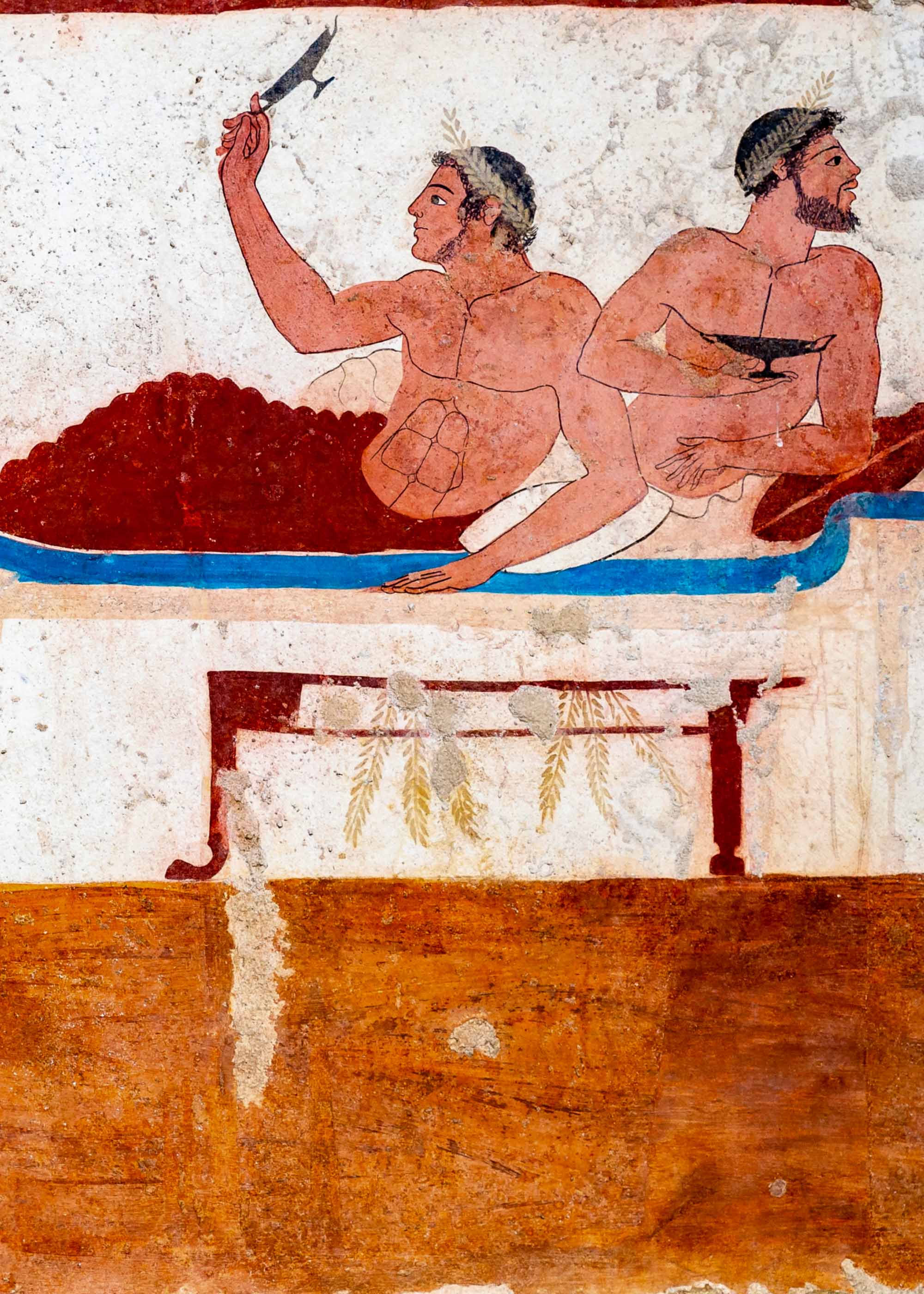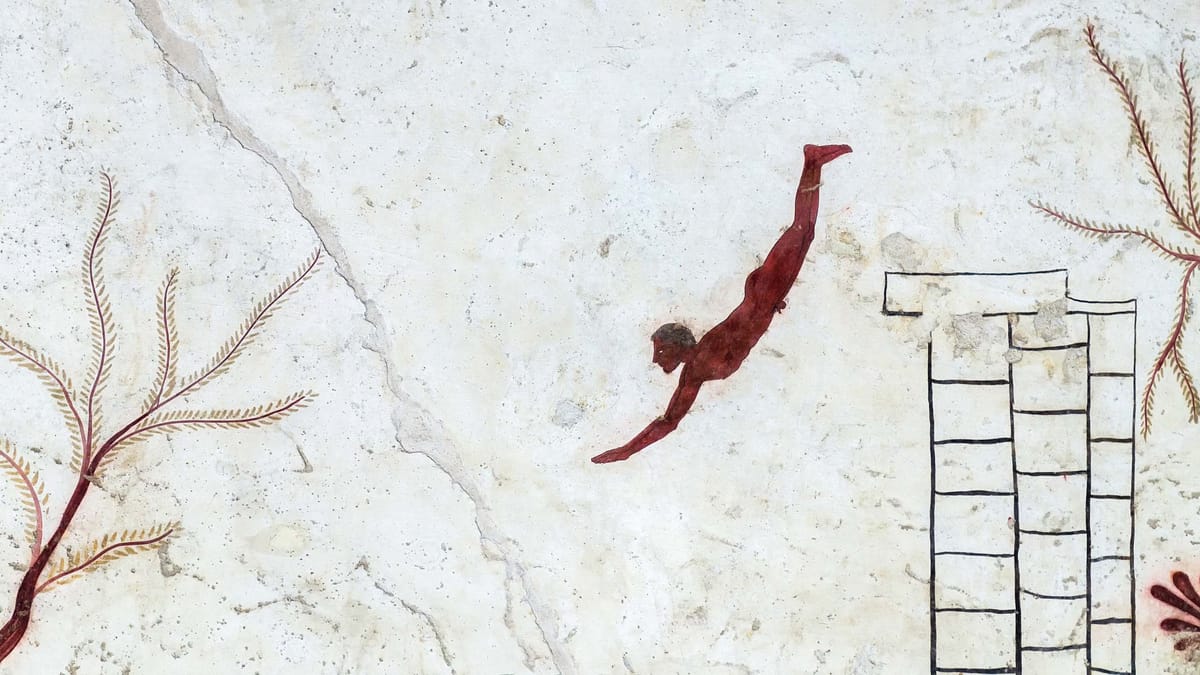Deep within the tranquil landscape of southern Italy lies one of the most evocative relics of Ancient Greece, nestled amid the rolling fields and gentle hills of Campania: Paestum. Once a thriving city of Magna Graecia, Paestum has gifted us a fascinating window into the ancient world, including the famed Tomb of the Diver. An enigmatic monument of artistic beauty and cultural depth, the Tomb of the Diver captures a unique historical moment, offering insight into the mysteries of life, death, and the elusive nature of human existence.
The History and Legacy of Paestum
Paestum, originally known as Poseidonia, was founded around 600 BCE by Greek colonists from Sybaris. Positioned close to the Tyrrhenian Sea, the city thrived as a bustling center of commerce and culture dedicated to Poseidon, the God of the sea. Over the centuries, Paestum transformed under the influence of different civilizations, from the Greeks to the Lucanians and then the Romans, each contributing to its architectural and cultural legacy.
Today, Paestum is renowned for its remarkably well-preserved Greek temples. The three grand temples dedicated to Hera, Athena, and Poseidon stand tall against the horizon, offering a powerful testament to the Greeks' architectural genius. These temples are some of the most impressive examples of Doric architecture outside mainland Greece, their colossal columns invoking a sense of grandeur and timelessness.
Amid these classical ruins, however, there is another wonder of Paestum that, while less imposing than the temples, is equally intriguing: the Tomb of the Diver.
Discovery of the Tomb of the Diver
The Tomb of the Diver was discovered in 1968 during an excavation led by archaeologist Mario Napoli. It was unearthed in a necropolis just outside the ancient city, near the main road linking Paestum with its surrounding territories. Unlike the many other tombs in Paestum, which generally conform to the standard forms of Greek funerary practices, this tomb stood out for its unique and enigmatic frescoes.
The tomb is a small limestone structure resembling a chest that dates back to around 470 BCE. It comprises five slabs—four lateral walls and a roof—and forms a rectangular chamber where the deceased was placed. What makes this tomb exceptional are the frescoes painted on its inner surfaces, particularly the striking image on the underside of the roof slab, which gave the tomb its name.
The Origin of the Tomb of the Diver
Scholars debate the origin of the Tomb of the Diver, found near Paestum, Italy. Some argue that it was constructed by either the nearby Greek settlement of Poseidonia (modern Paestum) or an Italic tribe inhabiting the surrounding region.
Arguments for Greek Origin:
- The presence of symposium scenes, a social gathering unique to ancient Greek culture, points towards a Greek origin for the tomb. The Etruscans, another prominent civilisation in the region, were not known for engaging in symposia.
- The artistic style employed in the frescoes, particularly the detailed anatomy, individualised features of the reclining figures, and the use of techniques like overlapping and foreshortening, closely resemble the style of red-figure Attic painting, a distinctly Greek artistic tradition.
- The use of Egyptian blue pigment, an expensive and uncommon colour, suggests the deceased was a wealthy individual, possibly belonging to the Greek elite of Poseidonia.
- The discovery of an Attic lekythos, a type of Greek vase, in black-figure technique dating to around 480 BCE, provides further evidence supporting a Greek origin and helps to date the tomb to around 470 BCE.
Arguments for Italic Origin:
- Some scholars point to the style of the vessel depicted on the east wall as evidence for an Italic origin. They identify this vessel as a krater-kantharos, a type of pottery often found in Italian tombs south of Poseidonia from the same period. This krater-kantharos differs from the more elaborate volute kraters typically found in Greek contexts, further supporting an Italic connection.
Further Evidence:
- While the symposium scenes point towards a Greek origin, the unusual choice of this theme for a funerary context adds complexity to the attribution debate.
- The Tomb of the Palmettes, a frescoed tomb found in Macedonia dating to the fifth century BCE, exhibits stylistic similarities to the Tomb of the Diver, particularly in the use of palmette decoration. This suggests a potential connection between the two tombs and a broader Greek artistic influence.
- Analysis of the pigments used in the Tomb of the Diver, compared with Lucanian frescoes predating it and other Greek frescoes from the same period, indicates a local artisanal painting specific to Paestum. This suggests that the tomb, regardless of its cultural origin, reflects a synthesis of artistic influences present in the region.
The question of whether the Tomb of the Diver was constructed by Greeks or an Italic tribe remains a matter of ongoing scholarly discussion. The evidence presents a complex picture, pointing to elements from both cultures. The tomb likely represents a point of cultural interaction and exchange between the Greek settlement of Poseidonia and the surrounding Italic populations.
The Frescoes: A Glimpse into Ancient Rituals
The walls of the Tomb of the Diver are adorned with vivid scenes of a symposium, a Greek drinking party, which was an important social ritual in Greek culture. The frescoes depict reclining figures enjoying wine, conversation, music, and the company of one another—a reflection of the convivial atmosphere that characterized these gatherings. The symposium scenes are rich in detail, featuring individuals playing the aulos (a double-reeded instrument), drinking from kylikes (shallow wine cups), and sharing in the communal experience of the banquet.
However, the most remarkable feature of the tomb is the fresco on the roof slab—an image of a solitary figure diving gracefully into a stylized body of water. This image evokes a profound mystery unlike anything else in Greek funerary art. The diver is depicted mid-air, his body arching elegantly as he plunges toward the water below. The simplicity of the composition, combined with its symbolic depth, has made this fresco one of the most intriguing artifacts from the ancient world.
Interpretations of the Diver
The image of the diver has sparked numerous interpretations over the years as scholars attempt to unravel its meaning. One common interpretation is that the diver represents the transition from life to death—a symbolic leap into the unknown. In this context, the water the diver plunges into can be seen as a metaphor for the afterlife, an uncharted and mysterious realm that all humans must eventually enter.
The diver's leap has also been interpreted as representing the soul's journey beyond the physical world, a moment of transcendence in which the individual leaves behind the material plane. This interpretation aligns with the Pythagorean and Orphic beliefs that were influential in southern Italy during the 5th century BCE. These philosophies emphasized the immortality of the soul and the idea of a transformative journey after death, suggesting that the fresco may reflect a broader cultural and spiritual worldview.
Another perspective views the diver as a metaphor for pursuing knowledge or enlightenment. The symposium scenes on the tomb walls provide a context for this interpretation, as the symposium was a social gathering and a setting for intellectual discourse and philosophical debate. The diver may symbolize the individual's quest for deeper understanding—a leap into the unknown in search of truth and wisdom.

The Unique Nature of the Tomb
What makes the Tomb of the Diver particularly remarkable is its uniqueness. Greek funerary art from this period typically focused on commemorative reliefs or painted scenes that depicted the deceased in a manner that emphasized their social status, family connections, or heroic deeds. In contrast, the Tomb of the Diver offers a deeply personal and introspective image that speaks to the individual's experience of life and death rather than their public identity.
The depiction of a diver in a funerary context is virtually unparalleled in the ancient Greek world, making this tomb an outlier in the broader tradition of Greek art. This uniqueness has led scholars to speculate about the identity of the person buried within the tomb. Was the diver someone with philosophical inclinations, perhaps influenced by the Pythagorean school? Was the tomb commissioned by someone who sought to express a personal belief about the nature of life and death? The lack of inscriptions or other identifying markers leaves these questions tantalizingly unanswered.
The Artistic Style and Influence
The frescoes of the Tomb of the Diver are notable not only for their subject matter but also for their artistic style. The figures are rendered in a manner that is both expressive and elegant, with an emphasis on movement and fluidity. The diver's body, in particular, is depicted with a naturalistic grace that captures the essence of the leap—a moment suspended in time.
The symposium scenes, too, are filled with a sense of vitality and interaction. The artists employed a limited color palette—primarily reds, blacks, and whites—yet managed to convey a lively atmosphere by carefully using line and form. The composition of the scenes, with their emphasis on reclining figures and communal activity, reflects the influence of contemporary Greek pottery, particularly the red-figure style that was popular in Athens during this period.
Interestingly, the frescoes also show local influences, suggesting that the artist may have drawn from Greek and indigenous Italic traditions. This blending of styles is characteristic of Paestum itself. This city existed at the crossroads of multiple cultures and was shaped by the interactions between Greek settlers, the native Lucanians, and later Roman conquerors.
A Symbol of Human Experience
The enduring allure of the Tomb of the Diver lies in its universality. The image of the diver, poised between the world of the living and the unknown depths below, speaks to a fundamental aspect of the human condition—the inevitability of death and the mystery beyond it. Unlike grand temples and monumental statues that celebrate the achievements of gods and heroes, the Tomb of the Diver offers a quiet meditation on the individual journey, one that is both deeply personal and profoundly relatable.
In a sense, the diver represents all of us—each of us must, at some point, take that final leap into the unknown. The simplicity of the image, combined with its powerful symbolism, evokes a sense of acceptance and wonder. It is a reminder that, despite the passage of millennia, the questions that preoccupied the ancient Greeks—questions about life, death, and what it means to be human—are still very much with us today.
Symbolism in the Tomb of the Diver
The Tomb of the Diver, located in Paestum, Italy, is adorned with frescoes that hold symbolic significance. They offer insights into ancient Greek beliefs and practices surrounding death and the afterlife.
Symposium Scenes and Their Interpretation
- The tomb's depiction of a Greek symposium, a social gathering for elite men involving drinking, entertainment, and philosophical discussions, is unusual for a funerary context.
- Scholars suggest that the symposium scenes might symbolize the deceased's passage into a pleasurable afterlife, continuing the enjoyment of earthly life in the hereafter.
- The nudity of some figures, particularly the central figure on the west wall, could represent formal undress, a convention in Greek art used to depict gods and heroic deaths, potentially elevating the deceased to a higher status.
- The presence of pederasty, a socially accepted relationship between an older man and a younger boy in ancient Greek culture, within the symposium scenes reflects the social dynamics and customs of the time.
Symbolism of the Diving Figure
- The diving figure on the tomb's ceiling has sparked various interpretations. Some believe the diver's trajectory symbolically links him to the kottabos game depicted on the north wall, suggesting a connection between the world of the living and the afterlife.
- The act of diving itself could represent the leap into the unknown, with the structure the diver leaps from symbolizing the boundary between the known world and the afterlife.
- The diver plunging into the water may also allude to the primordial waters of life, signifying a return to a state of origin and rebirth in the afterlife.
- The diving figure also parallels Etruscan tomb paintings, suggesting a possible exchange of funerary symbolism between the Greek and Etruscan cultures.
Additional Symbolic Elements
- The presence of Egyptian blue pigment in the frescoes indicates the deceased's wealth, as this pigment was expensive and not commonly used.
- The turtle shell found near the deceased likely belonged to a lyre, a musical instrument often associated with poetry and entertainment. It possibly symbolized the continuation of these pleasures in the afterlife.
The Tomb of the Diver offers a unique glimpse into ancient Greek funerary practices and beliefs. The symbolic elements, including the symposium scenes, the diving figure, and the use of rare pigments, suggest a focus on continuing earthly pleasures and the transition to a realm beyond the known world.
The Legacy of the Tomb of the Diver
Since its discovery, the Tomb of the Diver has become an iconic symbol of Paestum, drawing visitors worldwide who come to marvel at its frescoes and ponder its meaning. The tomb is now housed in the Archaeological Museum of Paestum, where it is displayed alongside other artifacts from the city's long history, providing context for the cultural and artistic achievements of this ancient community.
The tomb's legacy extends beyond its historical and artistic significance and has inspired contemporary artists, writers, and thinkers. The image of the diver has appeared in modern literature, poetry, and visual art, serving as a powerful metaphor for the human experience. Its enduring appeal lies in its ability to evoke a sense of connection across time, bridging the gap between the ancient world and our own.

A Timeless Leap
The Tomb of the Diver is more than just an archaeological artifact—it is a poignant reminder of the continuity of human experience. Its simple yet profound imagery captures what it means to be human: the desire to understand, the courage to face the unknown, and the awareness of our mortality. The diver's leap is a timeless symbol that speaks to the journey we must undertake, regardless of the era or culture in which we live.
As we stand before the frescoes of the Tomb of the Diver, we are invited to reflect on our lives and the leaps we must take. In doing so, we find ourselves connected to the past, to the people of Paestum who lived, loved, and wondered about the same mysteries that continue to intrigue us today. The Tomb of the Diver is not just a relic of a bygone era—it is a testament to the enduring spirit of humanity, a symbol of our shared journey into the unknown.






